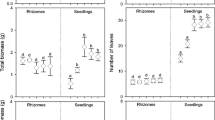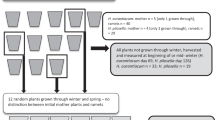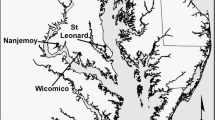Abstract
In this study, we examined how environmental factors and differences among populations of Lythrum salicaria L. (Lythraceae; purple loosestrife) influenced the establishment of this species into both its preferred wetland habitat and secondary upland habitat. Seeds and seedlings from five parents from each of the three populations were planted in each wetland and upland of two sites in both disturbed and undisturbed plots. More seeds germinated in wetland than in upland sites (31% as compared to 11%) and, although a disturbance resulted in greater germination (23% as compared to 17% in undisturbed plots), there was no interaction with habitats. The results of a simultaneous greenhouse germination study in which seeds were planted under saturated and drained conditions suggest that the higher germination observed in wetland sites was due to the higher moisture present at such sites (79% vs. 45% in saturated and drained conditions, respectively). Disturbance enhanced both germination and growth of L. salicaria and this was especially so for seedlings. Dry weights of seedlings from disturbed plots were five times greater than those from undisturbed plots (\(x\)=9.2 vs. 1.8 g in disturbed and undisturbed conditions, respectively). In addition to environmental factors, population differences are likely to play an important role in the spread of L. salicaria as we found differences between the populations in both life stages examined. One of the populations germinated equally well in both moisture treatments. In our seedling establishment experiment, one of the populations produced both the smallest plants and the most and earliest flowers, suggesting superior reproduction.
Similar content being viewed by others
References
Barrett SCH (1992) Genetics of weed invasions. In: Jain SK and Botsford LW (eds) Applied Population Biology, pp 91–119. Kluwer Academic Publishers, Dordrecht, The Netherlands
Carson WP and Root RB (2000) Herbivory and plant species coexistence: community regulation by a phytophagous insect. Ecological Monographs 70: 73–99
D'Antonio CM and Vitousek PM (1992) Biological invasions by exotic grasses, the grass/fire cycle, and global change. Annual Review of Ecology and Systematics 23: 63–87
Hobbs RJ and Huenneke LF (1992) Disturbance, diversity, and invasion: implications for conservation. Conservation Biology 6: 324–337
Horvitz CC, Pascarella JP, McMann S, Freedman A and Hofsetter RH (1998) Functional roles of invasive non-indigenous plants in hurricane-affected subtropical hardwood forests. Ecological Applications 8: 947–974
Lodge DM (1993) Biological Invasions: lessons for ecology. Trends in Ecology and Evolution 8: 133–137
Mack RN (1996) Predicting the identity and fate of plant invaders: emergent and emerging approaches. Biological Conservation 78: 107–121
Mal TK and Lovett-Doust J (1997) Morph frequencies and floral variation in a heterostylous colonizing wee Lythrum salicaria. d,. Canadian Journal of Botany 75: 1034–1045
Mal TK, Lovett-Doust J and Lovett-Doust L (1997) Effect of soil moisture and fertilizer application on clonal growth and reproduction in a tristylous weed, Lythrum salicaria. Canadian Journal of Botany 75: 46–60.
Mal TK, Lovett-Doust J, Lovett-Doust L and Mulligan GA (1992) The biology of Canadian weeds. 100. Lythrum salicaria. Canadian Journal of Plant Science 72: 1035–1330
Malecki RA, Blossey B, Hight SD, Schroeder D, Kok LT and Coulson JR (1993) Biological control of purple loosestrife. BioScience 43: 680–686
Moody ME and Mack RN (1988) Controlling the spread of plant invasions: the importance of nascent foci. Journal of Applied Ecology 25: 1009–1021
Mooney HA and Drake JA (1986) Biological Invasions of North America and Hawaii. Springer-Verlag, New York O'Neill P (1997) Natural selection on genetically correlated pheno-logical characters in Lythrum salicaria L. (Lythraceae). Evolution 51: 267–274
Parker IM, Mertens SK and Schemske DK (1993) Distribution of seven native and two exotic plants in tallgrass prairie in southeastern Wisconsin: the importance of human disturbance. American Midland Naturalist 130: 43–55
Pimentel D, Lach L, Zuniga R and Morrison D(2000) Environmental and economic costs of nonindigenous species in the United States. Bioscience 50: 53–65
Rachich J and Reader RJ (1999) An experimental study of wetland invasibility by purple loosestrife (Lythrum salicaria). Canadian Journal of Botany 77: 1499–1503
Sakai A, Allendorf FW, Holt JS, Lodge DM, Molofsky J, With KA, Baughman S, Cabin RJ, Cohen JE, Ellstrand NC, McCauley DE, O'Neill P, Parker IM, Thompson JN and Weller SG (2001) The population biology of invasive species. Annual Review of Ecology and Systematics 32: 305–332
SAS (1999) JMP, Version 3.2.2 Software for Statistical Visualization on the Apple Macintosh. SAS Institute, Inc, Cary, North Carolina
Shadel WP (2000) The influence of environmental and genetic factors on the spread of the invasive plant, Lythrum salicaria. Master's thesis, University of Vermont, Burlington
Shamsi SRA and Whitehead FH(1974) Comparative eco-physiology of Epilobium hirsutum L. and Lythrum salicaria L. I. General biology, distribution and germination. Journal of Ecology 62: 279–290
Thebaud C, Finzi AC, Affre L, Debussche M and Escarre J (1996) Assessing why two introduced Conyza differ in their ability to invade Mediterranean old fields. Ecology 7: 791–804
Thompson DQ, Stuckey RL and Thompson EB (1987) Spread impact and control of purple loosestrife (Lythrum salicaria) in North American wetlands. Fish and Wildlife Research Report 2: 55
Westbrooks RG (1998) Invasive plants, changing the landscape of America: fact book. In: Federal Interagency Committee for the Management of Noxious and Exotic Weeds, Washington, DC
Author information
Authors and Affiliations
Corresponding author
Rights and permissions
About this article
Cite this article
Paul Shadel, W., Molofsky, J. Habitat and Population Effects on the Germination and Early Survival of the Invasive Weed, Lythrum salicaria L. (purple loosestrife). Biological Invasions 4, 413–423 (2002). https://doi.org/10.1023/A:1023668918643
Issue Date:
DOI: https://doi.org/10.1023/A:1023668918643




